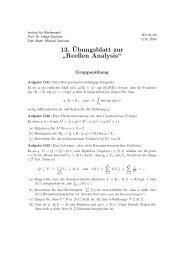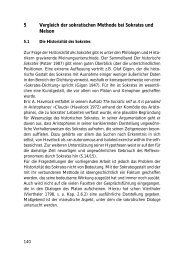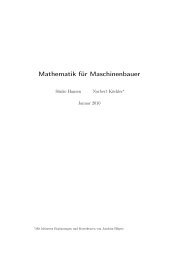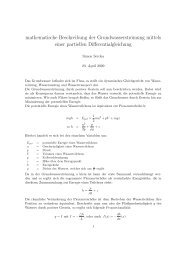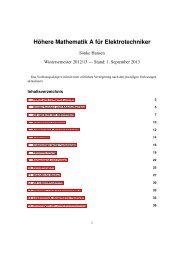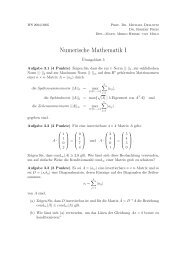Covering Pareto Sets by Multilevel Subdivision Techniques
Covering Pareto Sets by Multilevel Subdivision Techniques
Covering Pareto Sets by Multilevel Subdivision Techniques
You also want an ePaper? Increase the reach of your titles
YUMPU automatically turns print PDFs into web optimized ePapers that Google loves.
<strong>Covering</strong> <strong>Pareto</strong> <strong>Sets</strong> <strong>by</strong> <strong>Multilevel</strong><strong>Subdivision</strong> <strong>Techniques</strong>Michael Dellnitz ∗ and Oliver SchützeInstitute for MathematicsUniversity of PaderbornD-33095PaderbornGermanyThorsten HestermeyerMechatronics Laboratory PaderbornUniversity of PaderbornD-33095PaderbornGermanyAugust 7, 2003AbstractIn this work we present a new set oriented numerical method for the numericalsolution of multi-objective optimization problems. These methods areglobal in nature and allow to approximate the entire set of (global) <strong>Pareto</strong>points. After proving convergence of an associated abstract subdivision procedurewe use this result as a basis for the development of three differentalgorithms. We also consider appropriate combinations of them in order toincrease the total performance. Finally we illustrate the efficiency of thesetechniques both <strong>by</strong> several academic examples and <strong>by</strong> one concrete technicalapplication, namely the optimization of an active suspension system for cars.multi-objective optimization; <strong>Pareto</strong> set; global optimiza-Key words:tionAMS subject classification: 37N40; 49M37; 65K05; 90C30∗ http://math-www.uni-paderborn.de/~agdellnitz
1 IntroductionIn a variety of applications in industry or economy the problem arises that severalobjective functions have to be optimized at the same time. For instance, for a perfecteconomical production plan one wants to simultaneously minimize cost and maximizequality. This example already illustrates a natural feature of these problemsnamely that the different objectives typically contradict each other and thereforecertainly do not have identical optima. Thus, the question arises how to approximatethe “optimal compromises” – and this leads to the problem of multi-objectiveoptimization (MOP).In an (MOP) there are given k objective functions f 1 ,...,f k : Ê n → Ê whichhave to be minimized. The set of optimal compromises with respect to the objectivefunctions is called the <strong>Pareto</strong> set. Mathematically speaking a point x ∈ Ê n inparameter space is a <strong>Pareto</strong> point if there is no other point which is at least as goodas x in all the objectives and strictly better in at least one objective. Thus, thenumerical solution of an (MOP) consists of an approximation of the <strong>Pareto</strong> set.Multi-objective optimization is currently a very active area of research (see e.g.[15, 3, 22, 9] and references therein). Accordingly there exists a variety of differentapproaches for solving these problems. An excellent overview of deterministictechniques is given in [15]. Those methods are very similar in spirit to the traditionaloptimization techniques for classical (scalar) optimization problems. Anotherprominent approach is based on evolutionary algorithms [3, 22, 9]. These methodsare particularly advantageous in the situation where the (MOP) is discrete.Typically – that is under mild regularity conditions – the set of <strong>Pareto</strong> pointsis locally a (k − 1)-dimensional manifold if there are k smooth objective functions.In [11] this observation is used to construct an algorithm which allows to computepart of the <strong>Pareto</strong> set <strong>by</strong> numerical path following techniques. These methods areparticularly useful in the case where the set of <strong>Pareto</strong> points is one-dimensionaland connected. Otherwise either the continuation procedure becomes technicallyintractable for higher dimensional <strong>Pareto</strong> sets or disconnected parts of the <strong>Pareto</strong>set cannot be found due to the nature of these continuation procedures.A method which is based on a stochastic approach is presented in [17]. Moreconcretely there the authors derive a stochastic differential equation (SDE) for whichtypical solutions stay close to the <strong>Pareto</strong> set for a relatively long period of time. Thisknowledge can then be used to locate the <strong>Pareto</strong> set <strong>by</strong> a solution of the (SDE).Similar to the evolutionary strategies here the idea is to directly approximate the1
entire <strong>Pareto</strong> set and not just single <strong>Pareto</strong> points on the set.In this article we also use a global approach to compute approximations of theentire <strong>Pareto</strong> set. Our methods are set oriented and are based on the conceptspresented in e.g. [5, 4, 6]. The underlying idea is to write down an iteration schemewhich – interpreted as a discrete dynamical system – possesses the <strong>Pareto</strong> set asan attractor. Then set oriented numerical methods for dynamical systems can beused for its approximation. The dynamical systems (i.e. iteration schemes) we areconsidering here are obtained via suitable discretizations of the differential equationderived in [17]. However, in contrast to that work we do not have to add randomnessin our algorithms <strong>by</strong> a consideration of a related (SDE). Rather we are workingdirectly with the deterministic system itself.More concretely we propose three different set oriented multilevel approaches forthe approximation of the <strong>Pareto</strong> set. First we apply the techniques from [6] moreor less directly to the context of multi-objective optimization. That is, we present asubdivision algorithm for the approximation of <strong>Pareto</strong> sets which creates tight boxcoverings of these objects. We also discuss realizations and prove convergence resultsconcerning the abstract subdivision process. Since it can occur that in the courseof the subdivision procedure one loses part of the covering we present a recoveringalgorithm which can be viewed as a postprocessing procedure for the subdivisionscheme. This yields our second approach. In a third algorithm we combine thecreation of the box covering with appropriate branch&bound strategies which aresimilar in spirit to [12]. Finally we discuss a combination of all three algorithmssuch that the performance of the resulting algorithm is optimal.A detailed outline of the article is as follows. In Section 2 we recall the theoreticalbackground both for multi-objective optimization problems and for subdivisionschemes in the context of global zero finding. Here we also define the dynamical systemwhich is the basis for our set oriented numerical approach. In Section 3 we proveconvergence of certain iteration schemes towards the set of substationary points. Acombination of this result with results from [6] yields the desired convergence resultfor our subdivision procedure. The corresponding algorithms, realizations and extensionsare presented in Section 4. Finally, in Section 5we illustrate the efficiencyof our approach <strong>by</strong> several examples.2
In this article we develop set oriented numerical methods for the approximationof the set of global <strong>Pareto</strong> points. Let us illustrate the notion of (global and local)<strong>Pareto</strong> points <strong>by</strong> the following example.Example 2.3 In Fig. 1 we present an example of two objective functions f j : Ê →Ê, j =1, 2. In this case the set of local <strong>Pareto</strong> points consists of the union of theintervals [0, 1] and [1.5, 2]. However, only the points in the interval [1.5, 2] are alsoglobally <strong>Pareto</strong> optimal.6543210−1 −0.5 0 0.5 1 1.5 2 2.5 3xFigure 1: Two objective functions f j : Ê → Ê (j =1, 2) on the interval [−1, 3].A Necessary Condition for OptimalityIn our numerical methods we are going to make use of the following theorem ofKuhn and Tucker ([14]) which states a necessary condition for <strong>Pareto</strong> optimality.Theorem 2.4 Let x ∗ be a <strong>Pareto</strong> point of (MOP).Then there exist nonnegativescalars α 1 ,...,α k ≥ 0 such thatk∑α i =1i=1andk∑α i ∇f i (x ∗ )=0. (2.2)i=1Obviously (2.2) is not a sufficient condition for (local) <strong>Pareto</strong> optimality. Onthe other hand points satisfying (2.2) are certainly “<strong>Pareto</strong> candidates” and thus,following [15], we now emphasize their relevance <strong>by</strong> the followingDefinition 2.5 Apointx ∈ Ê n is called a substationary point if there exist scalarsα 1 ,...,α k ≥ 0 such that (2.2) is satisfied.4
Remark 2.6 Under certain smoothness assumptions it can be shown that the set ofsubstationary points locally typically defines a (k − 1)-dimensional manifold, wherek is the number of objectives described <strong>by</strong> F (see [11]). Essentially this is nothingelse but an immediate consequence of the Implicit Function Theorem.The Descent DirectionSimilar to classical iteration schemes for the numerical solution of scalar optimizationproblems we need to identify a descent direction for our numerical methods. Moreprecisely, for a point which is not substationary we need to know a direction in Ê nin which all the k objectives are simultaneously decreasing. For this purpose webriefly summarize in the following the main results of [17]. These results have to beviewed as the natural extension of the classical underlying theory for the method ofsteepest descent.FirstweassociatewithF : Ê n → Ê k , F (x) =(f 1 (x),...,f k (x)), the followingquadratic optimization problem:{k∑min ‖ α i ∇f i (x)‖ 2α∈Ê k 2 ; α i ≥ 0,i=1,...,k,i=1Then one can show the following result.Theorem 2.7 ([17]) Let q : Ê n → Ê n be defined <strong>by</strong>q(x) =where ˆα is a solution of (QOP).Thenk∑ˆα i ∇f i (x),i=1}k∑α i =1i=1(QOP)(i) either q(x) = 0 or −q(x) is a descent direction for all objective functionsf 1 ,...,f k in x;(ii) for each ˆx ∈ Ê n there is a neighborhood U(ˆx) and a constant Lˆx ≥ 0, suchthat‖q(x) − q(y)‖ 2 ≤ Lˆx ‖x − y‖ 2 for all x, y ∈ U(ˆx).By this result the initial value problemẋ(t) =−q(x(t)), x(0) = x 0 , (2.3)is well posed. Let x :[0, ∞[→ Ê n be the unique solution of (2.3). Then one canshow that this solution satisfiesF (x(s)) ≥ p F (x(t)) and F (x(s)) ≠ F (x(t)) for all 0 ≤ s
In fact, suppose additionally that the setR ≤p = {x ∈ Ê n : F (x) ≤ p F (x 0 )}is bounded. Then the solution x(t) has to converge to a substationary point for t →∞. Thus, a suitable discretization of the “generalized gradient system” (2.3) yieldsnumerical iteration schemes converging towards substationary points (see Sec. 3).Observe that <strong>by</strong> Theorem 2.7 each <strong>Pareto</strong> point is a zero of the function q.Therefore the aim is to find the set of zeros of q. Since these zeros are not isolated(cf. Remark 2.6) a set oriented approach turns out to be most adequate for theirapproximation. In the next paragraph we describe the general approach and, inparticular, the related subdivision procedure.2.2 The <strong>Subdivision</strong> AlgorithmWe now briefly review a subdivision algorithm for the approximation of the set ofzeros of a function in a compact domain. For a detailed exposition the reader isreferred to [6].We consider a finite collection of discrete dynamical systems of the typex j+1 = g l (x j ), j =0, 1, 2,...,where we assume for simplicity that each g l : Ê n → Ê n (l =1,...,s)isadiffeomorphism.Remark 2.8 In the applications we have in mind each function g l is an iterationscheme for finding zeros of a given function. For instance, the g l ’s can correspond tothe damped Newton’s method with s different step sizes. The subdivision algorithmpresented now allows to determine a close covering of the entire set of zeros.The following definitions are taken from [6]. Denote <strong>by</strong>Ω={1, 2,...,s} N 0the set of all sequences of the symbols {1, 2,...,s}. For ω =(ω i ) ∈ Ωsetω j =(ω 0 ,ω 1 ,...,ω j−1 ) and define for j ≥ 1g ω j = g ωj−1 ◦···◦g ω0 .6
Definition 2.9 Let g 1 ,...,g s : Ê n → Ê n be diffeomorphisms and let Q ⊂ Ê n becompact. Then the relative global attractor of g 1 ,...,g s with respect to Q is definedasA Q,g1 ,...,g s= ⋂ ⋂g ω j(Q) ∩ Q. (2.4)ω∈Ω j≥1Remarks 2.10 (a) Observe that A Q,g1 ,...,g scontains every set A which is invariantfor every g l , l =1,...,s. (Recall that a set A is invariant for a map g ifg(A) ⊂ A.)(b) Suppose that the g l ’s are iteration schemes representing the damped Newton’smethod for a function f with different step sizes. Let Q be a neighborhood ofthe set of zeros of f. ThenA Q,g1 ,...,g scontains all the zeros of f <strong>by</strong> part (a).We now present an algorithm for the numerical computation of the relative globalattractor A Q,g1 ,...,g swhere g 1 ,...,g s are diffeomorphisms. Using a multilevel subdivisionscheme this method produces a sequence of sets B 0 , B 1 , B 2 ,...where each B kconsists of finitely many subsets of Q covering the relative global attractor A Q,g1 ,...,g s.In the following we will call the elements B of B k boxes. By our construction below,the diameterdiam(B k )=maxdiam(B)B∈B ktends to zero for k →∞.In order to guarantee convergence we have to assume that each dynamical systemis applied infinitely often in the subdivision procedure. To make this precise wechoose a sequence {u k } ∞ k=1 with u k ∈{1,...,s} which has the property|{k : u k = l}|= ∞ for each l =1,...,s. (2.5)We now describe the multilevel subdivision procedure in more detail.The <strong>Subdivision</strong> AlgorithmLet B 0 be an initial collection of finitely many subsets of the compact set Q suchthat ∪ B∈B0 B = Q. ThenB k is inductively obtained from B k−1 in two steps:(i) <strong>Subdivision</strong> Construct from B k−1 a new system ˆB k of subsets such that⋃B =⋃BB∈ ˆB kB∈B k−1anddiam( ˆB k )=θ k diam(B k−1 ),7
where 0
3 Convergence towards <strong>Pareto</strong> <strong>Sets</strong>By Theorem 2.7 each <strong>Pareto</strong> point is a zero of the function q as defined in the sametheorem. In analogy to classical zero finding procedures with different step sizestrategies we now prove that an appropriate discretization of the ordinary differentialequation (2.3) will lead to iteration schemes which generate sequences convergingtowards substationary points. Here we essentially proceed along the lines of [7].Then we can conclude – using the convergence result in Proposition 2.11 – thatan application of the subdivision algorithm yields a close covering of the set ofsubstationary points.In order to simplify the notation we begin <strong>by</strong> defining for a nonnegative vectorb ∈ [0, 1] k the corresponding objective function (cf. (MOP))F b (x) =b T F (x).We assume that the derivative of each F b is Lipschitz continuous with (uniform)Lipschitz constant L.We now discretize (2.3) and consider the following iteration schemex j+1 = x j + h j p j , j =0, 1,.... (3.1)In the following we will sometimes denote the right hand side <strong>by</strong> P , i.e.P (x j )=x j + h j p j , j =0, 1,.... (3.2)The descent direction p j is chosen such that for positive constants σ, τ > 0−q(x j) T p j‖q(x j )‖‖p j ‖ ≥ σ and ‖p j‖≥τ‖q(x j )‖,where q(x j ) is defined in Theorem 2.7. The step size h j is an Armijo or a Powellstep size. Let x 0 be the initial point and suppose that the iteration can be perfomedfor j →∞such that the sequence (x j ) j=0,1,... lies within a compact set D ⊂ Ê n .Proposition 3.1 Suppose that x ∗ is an accumulation point of the sequence (x j ) j=0,1,... .Then x ∗ is a substationary point for the multi-objective optimization problem (MOP).Proof: First observe that if one of the x j ’s is a substationary point then we aredone (cf. Theorem 2.7).Thus, without loss of generality we may assume that x j → x ∗ for j → ∞and that none of the x j ’s is substationary. Consider the corresponding sequence9
a j =(α j 1 ,...,αj k) of solution vectors of the optimization problem (QOP) in step jof the iteration procedure. Since α1,...,α j j k ∈ [0, 1] we may assume that a j → a forj →∞. (Otherwise restrict the following considerations to a subsequence.)We now show that the sequence (x j ) converges to a stationary point for F a (x)and, thus, proving the desired result.Using the fact that h j is an Armijo or a Powell step size in x j we have <strong>by</strong> classicalresults on iteration schemes for optimization problems (see e.g. [7]) that there existsa constant θ>0 such that[(F aj (x j ) − F aj (x j+1 ) ≥ θ min −∇F aj (x j ) T ∇Faj (x j ) T ) 2]p jp j ,(3.3)‖p j ‖in each step of the iteration process. Observe that θ does not depend on j <strong>by</strong> theassumption on the uniform Lipschitz continuity of ∇F b .Now suppose that[( )F a (x j ) − F a (x j+1 )
Corollary 3.2 Suppose that the set S of substationary points is bounded and letD be a compact neighborhood of S.Then an application of the subdivision algorithmto D with respect to the iteration scheme (3.1) creates a covering of the entire setS, that is,S⊂Q k for k =0, 1, 2,...in the course of the subdivision process.Observe that we have shown that the covering obtained <strong>by</strong> the subdivision processbecomes “tight”. However we cannot prove convergence towards S withoutan additional assumption on its structure. We illustrate this fact <strong>by</strong> the followingexample.Example 3.3 Let us reconsider Example 2.3 (cf. Fig. 1). In that case an applicationof the subdivision algorithm to the interval D =[−1, 3] will converge to theinterval [0, 2]. Thus, we obtain a covering of the set S =[0, 1] ∪ [1.5, 2] but we alsoapproximate the additional part (1, 1.5).For a proof of this fact one has to observe that a box which contains the number1 as well as points which are bigger than 1 always has a nonzero intersection with itsimage under the iteration scheme (3.1). Moreover the image of this box also has anonzero intersection with its right neighbor. Proceeding with this neighboring boxwe see that all the boxes between 1 and 1.5have preimages in other boxes in eachstep of the subdivision process. Therefore the interval (1, 1.5) is never removed inthe selection step.We will see in Section 4 how to overcome the problem described in the previousexample in actual realizations of the algorithm. However, these considerations incombination with standard compactness arguments immediately lead to the followingconvergence result:Corollary 3.4 Suppose that the set S of substationary points is bounded and connected.LetD be a compact neighborhood of S.Then an application of the subdivisionalgorithm to D with respect to the iteration scheme (3.1) leads to a sequence ofcoverings which converges to the entire set S, that is,h(S,Q k ) → 0 for k =0, 1, 2,...,where h denotes the usual Hausdorff distance.The following remark addresses a straightforward but interesting consequence ofthis result.11
Remark 3.5 Under the assumptions of Corollary 3.4 we can conclude that the setS has to have trivial homotopy. For instance, in case of two objective functionson a (at least) two-dimensional parameter space the set S cannot be topologicallyequivalent to a circle.4 Algorithms, Realizations and ExtensionsIn this section we propose three different algorithms for the computation of the<strong>Pareto</strong> set of a given (MOP), or, to be more precise, we present algorithms for thecomputation of tight coverings of such sets. Moreover we propose some guidelineson how to combine these algorithms in order to increase the performance of therespective numerical schemes.4.1 <strong>Subdivision</strong> AlgorithmThe first algorithm is directly based on the theoretical considerations of the previoussection, in particular on Corollaries 3.2 and 3.4. In fact, we now discuss a concreterealization of the subdivision procedure for the computation of tight coverings ofthe set of substationary points using the dynamical systemx j+1 = P (x j )=x j + h j p j , j =0, 1,... .Descent Directionthe descent directionIn all the computations presented in this paper we have usedp j = q(x j ),cf. (3.1) and Theorem 2.7.For the specific case of bicriteria optimization problems (i.e. k = 2) one couldalternatively use the following descent direction:( ∇f1 (x j )p j = −+ ∇f )2(x j ).‖∇f 1 (x j )‖ 2 ‖∇f 2 (x j )‖ 2This choice is particularly useful in the case where the cost for the evaluation of∇f i , i =1, 2, is high. We have tested this descent direction with all the bicriteriaoptimization problems presented in this article yielding satisfying results.Step Length Following standard techniques for step length control – see e.g. [7] –we have chosen a particular Armijo step size strategy in the following way: starting12
with the given point x j we evaluate F along the descent direction p j in uniformstep lengths h 0 as long as the values of all objectives decrease. Once one objectivefunction starts to increase, a “better” iterate x j+1 with intermediate step length iscalculated via backtracking:(i) n := 1(ii) while F (x j + nh 0 p j ) < p F (x j +(n − 1)h 0 p j ) and〈∇f i (x j +(n − 1)h 0 p j ),p j 〉 < 0 ∀i =1,...,kset n := n +1(iii) choose x j+1 ∈ [x j +(n − 1)h 0 p j ,x j + nh 0 p j ]such that F (x j+1 ) < p F (x j +(n − 1)h 0 p j )Remarks 4.1 (a) To find an appropriate guess for the “scan length” h 0 it ispossible to take advantage of the subdivision scheme. If a step length ˜h hasbeen computed for a point ˜x inside a certain box then this distance can bechosen as the scan length for the following points inside the same box. Thisstrategy works particularly well when the subdivision scheme is at a level whereall the boxes are already quite small.(b) Concretely we propose the following backtracking procedure in step (2) above.For every i ∈{1,...,k} with f i (x j +nh 0 p j ) >f i (x j +(n−1)h 0 p j ) we determinex i j = x j +((n − 1)h 0 +Θ i )p j , Θ i ∈ (0, 1),via quadratic backtracking. Then setˆx j = x i jwhere i is chosen such that Θ i is minimal.If F (ˆx j ) < p F (x j +(n − 1)h 0 p j ) then the point ˆx j is accepted and we choosex j+1 =ˆx j in step (2). Otherwise proceed in the same way to find a new iteratebetween x j +(n − 1)h 0 p j and ˆx j .4.2 Recovering AlgorithmIt may be the case that in the course of the subdivision procedure boxes get lostalthough they contain substationary points. This will for instance be the case whenthere are not enough test points taken into account for the evaluation of F (B) foraboxB ∈B k (see Remark 2.13). We now describe an algorithm using a kind of13
”healing” process which allows to recover those substationary points which havepreviously been lost.Before we can state the algorithm we have to present some more technical detailsabout box collections. For theoretical purposes denote <strong>by</strong> P k a complete partitionof the set Q = Bĉ,ˆr into boxes of subdivision size – or depth 1 – k, whicharegenerated<strong>by</strong> successive bisection of Q. Then there exists for every point y ∈ Q andevery depth k exactly one box B(y, k) ∈P k with center c and radius r such thatc i − r i ≤ y i
(i) for all B ∈B kB.active := TRUE(ii) for i =1,...,MaxStepˆB k := B kfor all {B ∈B k : B.active == TRUE}choose starting points {s i } i=1,...,l near BX := {P q (s i )|i =1,...,l}B.active := FALSEfor all y ∈X:if B(y, k) ∉ B kB k := B k ∪ B(y, k)B(y, k).active := TRUEif ˆB k == B k STOPHence the recovering algorithm allows to add boxes to the given collection. Thedesired covering of the set S of substationary points cannot get worse but willimprove if the parameters of the algorithm are adjusted properly. On the otherhand, the recovering algorithm does not adequately perform in the case where abox does not contain part of S but is possibly far away. In this case the algorithmwould extend the box covering <strong>by</strong> many undesired regions on the way towards Sin the course of the iteration of test points. This observation is particularly validfor higher dimensional parameter spaces. A method which allows to overcome thisproblem can be found in [19].4.3 Sampling AlgorithmObserve that there are a couple of potential drawbacks which may occur when usingthe two algorithms described above:(a) the gradients of the objectives are needed,(b) the set S is generally a strict superset of the <strong>Pareto</strong> set, and(c) the algorithms are capable of finding local <strong>Pareto</strong> points on the boundary ofthe domain Q – e.g. via penalization strategies. However, it turned out inpractice that (MOP)s typically contain many local <strong>Pareto</strong> points on ∂Q whichare not globally optimal (see e.g. Fig. 3).The following sampling algorithm avoids all these problems because it takes onlythe function values of the objective functions into account. On the other hand this15
algorithm is not as robust to errors as the first two ones because it is only globalrelative to the underlying box collection.In the following we call a point x ∈X ⊂Ê n nondominated with respect to Fand X if there does not exist a point y ∈X with F (y) ≤ p F (x) andF (y) ≠ F (x).Using this notion an outline of the algorithm is as follows. Given a box collectionB k−1 the collection B k is obtained <strong>by</strong>:(i) <strong>Subdivision</strong>Construct from B k−1 a new system ˆB k of subsets such that⋃B =B∈ ˆB k⋃B∈B k−1Banddiam( ˆB k )=θ k diam(B k−1 ),where 0
0 0.2 0.4 0.6 0.8 1 1.2 1.4 1.6 1.8 26f 1f 2540354302532015210510| |ab0010203040 0 5 10 15 20 25 30 35 40Figure 3: Examples of (MOP)s with optima relative to the boundary. Left: thepoint a is a <strong>Pareto</strong> point of the (MOP) given <strong>by</strong> F (x) =(f 1 (x),f 2 (x)) and Q =[a, b].Right: a covering of the set of local <strong>Pareto</strong> points. For a detailed discussion of thisparticular (MOP) we refer to Sec. 5.3.a local and a global <strong>Pareto</strong> point. Furthermore the efficiency of the algorithm willget worse when the (MOP) has optima relative to the boundary of the domain.The recovering algorithm is able to extend the computed box covering of the setof substationary points but it is just local in nature.The sampling algorithm is able to detect global <strong>Pareto</strong> points even on the boundaryof the domain due to the fact that it works in the image space of the (MOP).However, there remains always uncertainty because of the sampling approach, inparticular when the boxes are big and/or the dimension of the (MOP) is large. Neverthelessit turned out in practice that this algorithm works quite well, in particularwhen the gradients of the objectives are not available and the dimension of the(MOP) is moderate.To obtain an even better better performance – i.e. to compute a robust approximationof the <strong>Pareto</strong> set and to use a moderate amount of function calls – wepropose the following combination of the three algorithms. Here we assume that thegradients of all objectives are available.step 1 Start with the subdivision algorithm because of its robustness. Take a fewtest points for the evaluation of the boxes via the dynamical system P .step 2 Apply the recovering algorithm to the box collection which has been computedin step 1. This fills the gaps which have possibly been generated in step 1.step 3 Use the sampling algorithm to tighten the extended box collection. By usingthis algorithm boxes which only contain local <strong>Pareto</strong> points can be removedfrom the covering. Furthermore boxes get removed which contain no substa-17
tionary points but where kept in step 1 because of the weak convergence of Pin these regions.There are of course other possible ways to combine the algorithms, e.g. it ispossible to apply again the first algorithm on the box collection obtained <strong>by</strong> theprocedure described above. In step 2 the number of boxes which are added to thecollection is a measure for the number of test points needed in step 1.5 Numerical ResultsIn this section we illustrate the efficiency of our set oriented algorithms <strong>by</strong> severalnumerical examples.5.1 Example 1We begin <strong>by</strong> considering a simple example in order to illustrate the working principleof the subdivision procedure.The (MOP) is given <strong>by</strong> two objective functions f 1 ,f 2 : R 2 → R,f 1 (x 1 ,x 2 )=(x 1 − 1) 2 +(x 2 − 1) 4 ,f 2 (x 1 ,x 2 )=(x 1 +1) 2 +(x 2 +1) 2 .The basic region in parameter space is chosen to be Q =[−5, 5] × [−5, 5]. In Fig. 4we show box coverings generated <strong>by</strong> the subdivision algorithm after several stepsindicating that these sets indeed converge to the set of <strong>Pareto</strong> points.5.2 Example 2In this example we consider three objective functions f 1 ,f 2 ,f 3 : R 3 → R,f 1 (x 1 ,x 2 ,x 3 )=(x 1 − 1) 4 +(x 2 − 1) 2 +(x 3 − 1) 2 ,f 2 (x 1 ,x 2 ,x 3 )=(x 1 +1) 2 +(x 2 +1) 4 +(x 3 +1) 2 ,f 3 (x 1 ,x 2 ,x 3 )=(x 1 − 1) 2 +(x 2 +1) 2 +(x 3 − 1) 4 .The basic domain is chosen as Q =[−5, 5] 3 . Also in this higher dimensional casethe subdivision algorithm can successfully be applied. Resulting box collections areshown in Figs. 5and 6.18
5948372610−1−2−3−4−5−5 −4 −3 −2 −1 0 1 2 3 4 5f 25432100 2 4 6 8 10 12 14 16 18 20f 1Figure 4: Successive approximations of the <strong>Pareto</strong> set. Left: B 2 (yellow), B 4 (green),B 10 (red) and B 20 (black); right: the image F (B 20 ), i.e. an approximation of the<strong>Pareto</strong> optimal solutions in image space.5.3 Example 3We now solve an (MOP) which serves as a model for a problem occuring in productionplanning (cf. [17]). Here we have two objective functions f 1 ,f 2 : Ê n → Ê,wherew j (z) =f 1 (x) =n∑x j ,j=1f 2 (x) = 1−n∏(1 − w j (x j )),j=1{0.01 · exp(−(z20 )2.5 ) for j =1, 20.01 · exp(− z 15 for 3 ≤ j ≤ nThe two objective functions have to be interpreted as follows. f 1 represents the sumof the additional cost necessary for a more reliable production of n items. Theseitems are needed for the composition of a certain product. The function f 2 describesthe total failure rate for the production of this composed product.The basic domain is Q =[0, 40] n .Forn =3andn = 20 the approximations areshown in Fig. 7. These were obtained <strong>by</strong> the sampling algorithm which is capableto detect <strong>Pareto</strong> optimal solutions on the boundary of the domain Q. Incomparisonto this we show in Fig. 3 a covering obtained <strong>by</strong> the subdivision algorithm on itsown combined with a penalization strategy. It can be observed that in this case theuse of the sampling algorithm is certainly advantageous.19
2.521.510.50−0.5−1−1.5−2−2.51.510.50−0.5−1−1.52110−1−2−1−1.5−0.500.511.50.50−0.5−1−1.5−1−0.500.511.5110.50.500−0.5−0.5−1−1110.50−0.5−1−1−0.500.510.50−0.5−1−1−0.500.51Figure 5: Box collections B 10 , B 15 , B 20 and B 25 .20
Figure 6: The box covering B 33 . The visualization was done <strong>by</strong> Grape(http://www.iam.uni-bonn.de/sfb256/grape/)5.4 Example 4We now revisit the second example to illustrate how the different algorithms canbe combined to achieve a better performance. The result shown in Fig. 8 wasobtained <strong>by</strong> the following steps: first the subdivision algorithm was applied for 21steps using only the center point of every box as the test point for the dynamicalsystem P (Fig. 8(a)). Using only these few test points the computed box collectionB 21 already reveals the shape of the set of <strong>Pareto</strong> points but it also contains manyholes. These holes could be filled <strong>by</strong> an application of the recovering algorithm onB 21 (Fig. 8(b)). Finally, the covering was tightened using the sampling algorithm.5.5 Example 5 - Optimization of an Active SuspensionIn this section we illustrate that the developed algorithms can be useful in applicationsto real world problems. The following example of optimizing an activesuspension is taken from the field of automotive engineering. As it is not the aimof this paper to focus on suspension technology, the problem will be dealt with onlyin a reduced form.It is common in suspension engineering to analyze basic principles of the active21
32.54035302252015105total failure rate (%)1.5104030400.520100010203000 20 40 60 80 100 120sum of additional cost1816x 34035302520151050total failure rate (%)14121086430x 2201000510152025x 1303200 100 200 300 400 500 600 700 800sum of additional costFigure 7: Results for Example 3: For dimension n = 3 (top) after 30 iterations andfor dimension n = 20 (bottom) after 100 iterations in parameter space (left) and inimage space (right).22
−11110.50.50.5000−0.5−0.5−0.5−1−1−11110.50−0.5−1−0.500.510.50−0.5−1−1−0.500.510.50−0.5−1−1−0.500.51(a) <strong>Subdivision</strong>(b) Recovering(c) Sampling AlgorithmFigure 8: Combination of the three algorithmssuspension regarding system set-up and controller design <strong>by</strong> using quarter car models.These models consist of the proportional mass of the car body, one wheel andthe respective strut 2 ([16], [8]). Due to energy considerations, the active interventionof the suspension is usually restricted to lower frequencies (e.g. [1]), which are –in good approximation – characterized <strong>by</strong> the dynamical behavior of the car bodyonly. The basic design of the active suspension can therefore be based on a simplemodel as illustrated in Fig. 9.Figure 9: Simplified quarter car modelThe road z 0 excites the mass m B with its coordinate z B via the strut with springconstant c strut and damping constant d strut . The active suspension allows for anadditional active force F active . Using acceleration and level measurements, the carbody dynamics can be attuned to the transfer function given in (5.1) and describedin the Laplace-domain. 3G (s) = z Bd s+c(s) =(5.1)z 0 m B s 2 +(d + d s )s+cThe spring constant c and the damper constant d are composed of the physicalconstants c strut and d strut , respectively, and an additional controller part using the2 The link kinematics can be considered <strong>by</strong> scaling the parameters of the strut <strong>by</strong> an appropriatetranslation factor.3 In order to keep the example simple, actuator influences are disregarded here, as are derivativeand measurement filters. An integrating controller part is dispensed with for the same reasons.23
elative velocity between road and car body. The additional damper term d s sinthedenominator can be obtained <strong>by</strong> using the absolute car body velocity derived froma measurement of the acceleration.The fundamental design problem of (5.1) is depicted in Fig. 10 (see also [10]).The left-hand side shows the response of the car body to a step on the road ofheight 1 cm. The spring constant c is kept constant, d and d s are varied such thatd + d s = const. With increasing d s , the overshoot decreases, which means that thedriving comfort increases.Figure 10: Step and ramp response of the car bodyAt the same time it becomes difficult to move up a ramp – this fact is illustratedon the right hand side of Fig. 10. The ramp excitation corresponds to a drive with20 m on a 15% slope. When the damping of the system is realized <strong>by</strong> d sec s only(d = 0), the simulation shows a ramp error of 57 cm, which means that the car hitsthe mechanical buffers while driving along the slope. Thus, in order to optimizethe suspension behavior, it is apparently necessary to consider not only a comfortcriterion but also the ramp error.Driving tests show that a body response of 1 Hz and a damping of 0.6 are perceivedto be particularly comfortable. This suggests (5.2) as a reference car bodyresponse with respect to comfort.G c.o. (s) =1T c.o. s 2 +2d c.o. s+1| T c.o. = 12 πradsec , d c.o. =0.6 (5 .2)The difference between (5.1) and (5.2) can be used as a criterion for comfort. Asboth functions are minimum phase, it is sufficient to compare the magnitudes of thetransfer functions. These considerations lead to (5.3) as the first objective function:f 1 =∑∣ )∣ ∣ )∣) ∣∣G(20 log 10(i10 −3+ j450∣∣ ∣∣Gc.o.− 20 log10(i10 −3+ j450∣∣2(5.3)j=0,...,45024
As we have already seen in Fig. 10 it is necessary to add another criterion for theramp error. Computing the ramp error for t →∞, we obtain the following secondobjective functionf 2 = lim s(1− G (s)) 1s→0 s = d s2 c . (5.4)c, d and d s are the free parameters for the optimization, m B is set to 250 kg. Allparameters must be positive to avoid rhs-poles and zeros. f 1 and f 2 are both positivepenalty functions 4 .Thusf 1 ,f 2 : R +,3 → R + .The result of the multiobjective optimization is shown in Fig. 11.Figure 11: Result of the multiobjective optimization using the sampling algorithmThe <strong>Pareto</strong> set can be divided into two parts: the upper part in parameter spacewith d s > 0 belongs to the right hand part of the ’Objectives‘-diagram in Fig. 11.This part is magnified in the inner figure. The second part in parameter space lies inthe plane where d s = 0. The corresponding curve in image space has an extremelysteep gradient. However, from a physical point of view this branch is irrelevant.The extremal substationary points of the multi-objective optimization problem aretherefore the points 1 and 2 (see left hand side in Fig. 11). Point 1 is ramp-oriented,point 2 comfort-oriented.In Fig. 12 we show the time and frequency response of the car body correspondingto both of these points.4 For numerical reasons, the parameters lie within the intervalsc ∈ [1, 20000] d ∈ [0, 5000] d s ∈ [0, 5000]As the result shows, these restrictions have no impact on the optimization.25
Figure 12: Time and frequency responses of the extreme <strong>Pareto</strong> pointsThe comfort-oriented substationary point yields the prescribed comfort optimum(5.2), which can be seen both in the frequency and in the time domain. The ramporientedsubstationary point returns a ramp error of 0 (only suggested <strong>by</strong> ∆z ramp inFig. 12, but it can clearly be seen in Fig. 11). However, with 0.26, the damping of thissystem is unnecessarily low 5 . This is due to the choice of the comfort criterion f 1 .The ramp-oriented frequency response in Fig. 12 illustrates the reason: its deviationfrom the comfort optimum around its peak response is weighed in the same wayas the deviation at higher frequencies far below 0 dB gain. An increase of dampingusing d instead of d s (and thus improving damping without deteriorating the ramperror) leads to a lower peak-response but also to higher gain at higher frequencies.This problem could be dealt with <strong>by</strong> the use of penalty functions. However, furtherimprovements of the objective functions will be discussed elsewhere.The optimized set of parameter values determined in the way presented hereallows for a controller tuning according to the target customer group. The suspensiondesign process can be simplified, as test drivers just need to switch between<strong>Pareto</strong> points and thus do not have to tune all free parameters without additionalsupport. In addition, multi-objective optimization of suspension controllers also hasthe potential for further suspension improvements. For instance, in [10] it is shownthat the <strong>Pareto</strong> set can be used for the self-optimization of a car.5 But it still lies within the range of today’s suspensions.26
6 ConclusionIn this article we present new set oriented algorithms for the solution of global multiobjectiveoptimization problems. We have analyzed their convergence properties andwe have demonstrated their efficiency <strong>by</strong> several numerical examples. Due to the setoriented approach the algorithms are robust and they are able to approximate theentire set of global <strong>Pareto</strong> points within a compact domain. Furthermore they canin principle be applied both to smooth and to non-differentiable objectives. On theother hand, the computational time is quite large in higher dimensional parameterspace. We expect to overcome this problem <strong>by</strong> a construction of more efficientiteration schemes. Finally, the modification of these techniques for an applicationto discrete (MOP)s will be another challenge for further investigations.Acknowledgement The authors would like to thank Joachim Lückel for his suggestionto get into the interesting field of multi-objective optimization. Katrin Baptistas well as Frank Scharfeld helped the authors with fruitful discussions. This workwas partly supported <strong>by</strong> the Deutsche Forschungsgemeinschaft within the SFB 376and the SFB 614.References[1] G. Castiglioni, K. Jäker, and F. Schlüter. Das aktive Fahrwerk mit elektrischenAktuatoren. AT Automatisierungstechnik, 07 1996.[2] I. Chauduri, S. Sertl, H. Zoltán, M. Dellnitz, and T. Fraunheim. Global optimizationof silicon nanoclusters. Submitted to Applied Surface Science, 2003.[3] K. Deb. Multi-Objective Optimization Using Evolutionary Algorithms. Wiley, 2001.[4] M. Dellnitz and A. Hohmann. The computation of unstable manifolds using subdivisionand continuation. In H.W. Broer, S.A. van Gils, I. Hoveijn, and F. Takens, editors,Nonlinear Dynamical Systems and Chaos, pages 449–459. Birkhäuser, PNLDE19, 1996.[5] M. Dellnitz and A. Hohmann. A subdivision algorithm for the computation of unstablemanifolds and global attractors. Numerische Mathematik, 75:293–317, 1997.[6] M. Dellnitz, O. Schütze, and St. Sertl. Finding zeros <strong>by</strong> multilevel subdivision techniques.IMA Journal of Numerical Analysis, 22(2):167–185, 2002.[7] J.E. Dennis and R.B. Schnabel. Numerical Methods for Unconstrained Optimizationand Nonlinear Equations. Prentice-Hall, 1983.[8] D. Fischer, M. Börner, and R. Isermann. Control of mechatronic semi-active vehiclesuspensions. In 2nd IFAC Conference on Mechatronic Systems, Berkeley, Ca. IFAC,2002.[9] C.M.Fonseca,P.J.Fleming,E.Zitzler,K.Deb,andL.Thiele.Evolutionary Multi-Criterion Optimization. Second International Conference, EMO 2003. Springer, 2003.27
[10] T. Hestermeyer and O. Oberschelp. Selbstoptimierende Fahrzeugregelung - VerhaltensbasierteAdaption. In Intelligente mechatronische Systeme, volume 122 of HNI-Verlagsschriftenreihe. Heinz Nixdorf Institut, 2003.[11] C. Hillermeier. Nonlinear Multiobjective Optimization - A Generalized HomotopyApproach. Birkhäuser, 2001.[12] R. Horst and H. Tuy. Global Optimization: Deterministic Approaches. Springer,1993.[13] O. Junge. Mengenorientierte Methoden zur numerischen Analyse dynamischer Systeme.PhD thesis, University of Paderborn, 1999.[14] H. Kuhn and A. Tucker. Nonlinear programming. Proc. Berkeley Symp. Math. Statist.Probability, (J. Neumann, ed.), pages 481–492, 1951.[15] K. Miettinen. Nonlinear Multiobjective Optimization. Kluwer Academic Publishers,1999.[16] M. Mitschke. Dynamik der Kraftfahrzeuge, volume C: Fahrverhalten. Springer Verlag,2nd edition, 1990.[17] S. Schäffler, R. Schultz, and K. Weinzierl. Astochastic method for the solution ofunconstrained vector optimization problems. J. Opt. Th. Appl., 114(1):209–222, 2002.[18] O. Schütze. Anew data structure for the nondominance problem in multi-objectiveoptimization. In C. M. Fonseca, P. J. Fleming, E. Zitzler, K. Deb, and L. Thiele,editors, Evolutionary Multi-Criterion Optimization (EMO 03), volume 2 of Springer,2003.[19] O. Schütze, S. Mostaghim, M. Dellnitz, and J. Teich. <strong>Covering</strong> <strong>Pareto</strong> sets <strong>by</strong> multilevelevolutionary subdivision techniques. In C. M. Fonseca, P. J. Fleming, E. Zitzler,K. Deb, and L. Thiele, editors, Evolutionary Multi-Criterion Optimization, LectureNotes in Computer Science, 2003.[20] S. Sertl and M. Dellnitz. Global optimization using a dynamical systems approach.Submitted to J. Glob. Optim., 2003.[21] V. <strong>Pareto</strong>. Cours d’Economie Politique. Libraire Droz, Genève, 1964 (first edition in1896).[22] E. Zitzler, K. Deb, L. Thiele, C. A. Coello Coello, and D. Corne. EvolutionaryMulti-Criterion Optimization. First International Conference, EMO 2001. Springer,2001.28




